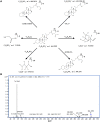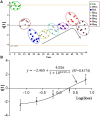Untargeted Metabolomics Reveals Dose-Response Characteristics for Effect of Rhubarb in a Rat Model of Cholestasis
- PMID: 27065293
- PMCID: PMC4814850
- DOI: 10.3389/fphar.2016.00085
Untargeted Metabolomics Reveals Dose-Response Characteristics for Effect of Rhubarb in a Rat Model of Cholestasis
Abstract
Cholestasis is a serious manifestation of liver diseases with limited therapies. Rhubarb, a widely used herbal medicine, has been frequently used at a relatively large dose for treating cholestasis. However, whether large doses are optimal and the therapeutic mechanism remain unclear. To explore these questions, the anti-cholestatic effect of five doses of rhubarb (0.21, 0.66, 2.10, 6.60, and 21.0 g/kg) in an alpha-naphthylisothiocyanate (ANIT)-induced rat model of cholestasis was examined by histopathology and serum biochemistry. A dose-dependent anti-cholestatic effect of rhubarb (0.21-6.6 g/kg) was observed, and an overdose of 21.0 g/kg showed a poor effect. LC-MS-based untargeted metabolomics together with pathway analysis were further applied to characterize the metabolic alterations induced by the different rhubarb doses. Altogether, 13 biomarkers were identified. The dose-response curve based on nine important biomarkers indicated that doses in the 0.42-6.61 g/kg range (EC20-EC80 range, corresponding to 4.00-62.95 g in the clinic) were effective for cholestasis treatment. The pathway analysis showed that bile acid metabolism and excretion, inflammation and amino acid metabolism were altered by rhubarb in a dose-dependent manner and might be involved in the dose-response relationship and therapeutic mechanism of rhubarb for cholestasis treatment.
Keywords: cholestasis; dose response; metabolomics; pathway analysis; rhubarb.
Figures







Similar articles
-
An integrated metabolomics strategy to reveal dose-effect relationship and therapeutic mechanisms of different efficacy of rhubarb in constipation rats.J Pharm Biomed Anal. 2020 Jan 5;177:112837. doi: 10.1016/j.jpba.2019.112837. Epub 2019 Aug 26. J Pharm Biomed Anal. 2020. PMID: 31493746
-
UPLC-MS-based metabonomic analysis of intervention effects of Da-Huang-Xiao-Shi decoction on ANIT-induced cholestasis.J Ethnopharmacol. 2019 Jun 28;238:111860. doi: 10.1016/j.jep.2019.111860. Epub 2019 Apr 6. J Ethnopharmacol. 2019. PMID: 30965080
-
Integrated 16 S rRNA gene sequencing and serum metabolomics approaches to decipher the mechanism of Qingre Lidan decoction in the treatment of cholestatic liver injury.J Pharm Biomed Anal. 2023 Sep 20;234:115535. doi: 10.1016/j.jpba.2023.115535. Epub 2023 Jun 16. J Pharm Biomed Anal. 2023. PMID: 37390604
-
Synergistic effects of rhubarb-gardenia herb pair in cholestatic rats at pharmacodynamic and pharmacokinetic levels.J Ethnopharmacol. 2015 Dec 4;175:67-74. doi: 10.1016/j.jep.2015.09.012. Epub 2015 Sep 13. J Ethnopharmacol. 2015. PMID: 26376237
-
A Systematic Review of Rhubarb (a Traditional Chinese Medicine) Used for the Treatment of Experimental Sepsis.Evid Based Complement Alternat Med. 2015;2015:131283. doi: 10.1155/2015/131283. Epub 2015 Aug 3. Evid Based Complement Alternat Med. 2015. PMID: 26339264 Free PMC article. Review.
Cited by
-
Identification of potential biomarkers in cholestasis and the therapeutic effect of melatonin by metabolomics, multivariate data and pathway analyses.Int J Mol Med. 2018 Nov;42(5):2515-2526. doi: 10.3892/ijmm.2018.3859. Epub 2018 Sep 5. Int J Mol Med. 2018. PMID: 30226547 Free PMC article.
-
Integrated dose-response metabolomics with therapeutic effects and adverse reactions may demystify the dosage of traditional Chinese medicine.Chin Med. 2022 Nov 19;17(1):130. doi: 10.1186/s13020-022-00687-4. Chin Med. 2022. PMID: 36403018 Free PMC article.
-
Chemical and genetic discrimination of commercial Guangchenpi (Citrus reticulata 'Chachi') by using UPLC-QTOF-MS/MS based metabolomics and DNA barcoding approaches.RSC Adv. 2019 Jul 29;9(40):23373-23381. doi: 10.1039/c9ra03740c. eCollection 2019 Jul 23. RSC Adv. 2019. PMID: 35514483 Free PMC article.
-
Metabolomic Study on Idiosyncratic Liver Injury Induced by Different Extracts of Polygonum multiflorum in Rats Integrated with Pattern Recognition and Enriched Pathways Analysis.Front Pharmacol. 2016 Dec 15;7:483. doi: 10.3389/fphar.2016.00483. eCollection 2016. Front Pharmacol. 2016. PMID: 28018221 Free PMC article.
-
Investigation of Liver Injury of Polygonum multiflorum Thunb. in Rats by Metabolomics and Traditional Approaches.Front Pharmacol. 2017 Nov 1;8:791. doi: 10.3389/fphar.2017.00791. eCollection 2017. Front Pharmacol. 2017. PMID: 29163173 Free PMC article.
References
LinkOut - more resources
Full Text Sources
Other Literature Sources

